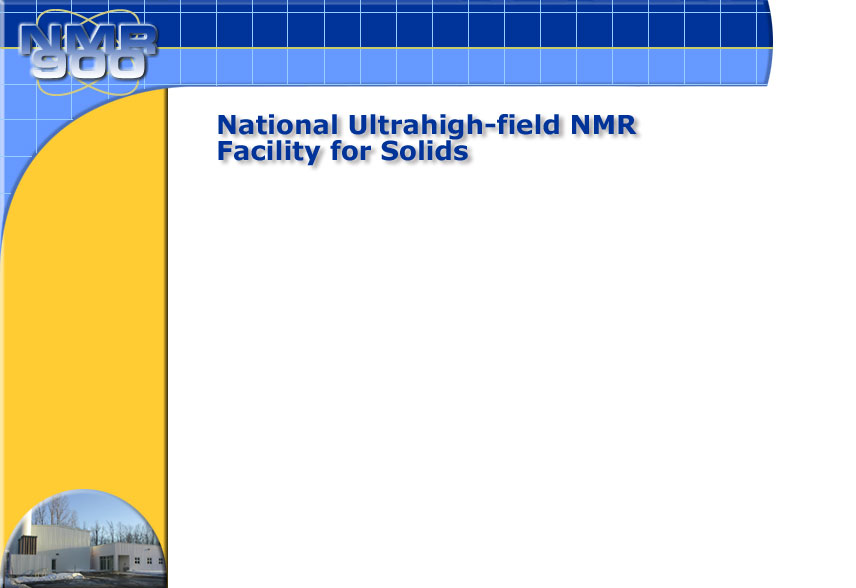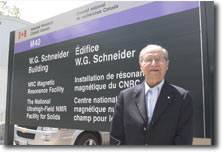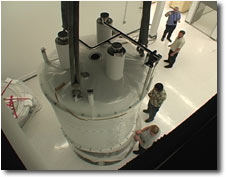
What's
New
Heavy-Duty Magnet Lands at NRC
(Ottawa: June 1, 2005)
Dr. William G. Schneider, famous for his pioneering work in high-resolution nuclear magnetic resonance (NMR), visited NRC’s Montreal Road Campus to witness the arrival of a large, ultrahigh-field superconducting NMR magnet at the M-40 building. The delivery date for the 900 MHz (21.1 Tesla) spectrometer was made more special as it just happened to coincide with the eminent scientist’s 90th birthday!
 Dr. Schneider’s work led to the publication of the first comprehensive
review of the NMR discipline in 1959. The publication was used as a textbook
and an authoritative source for the topic during the next 10 years. The true
impact of NMR is apparent, having led to advances in determining structures
for materials and complex natural products with a variety of applications.
Dr. Schneider’s work led to the publication of the first comprehensive
review of the NMR discipline in 1959. The publication was used as a textbook
and an authoritative source for the topic during the next 10 years. The true
impact of NMR is apparent, having led to advances in determining structures
for materials and complex natural products with a variety of applications.
Dr. William G. Schneider next to the M-40
building
 The new 900 MHz NMR spectrometer will be a major component of the facilities
housed in the M-40 building, recently named after Dr. Schneider to honour
him as past NRC President and as a foremost pioneer in NMR spectroscopy. The
spectrometer will continue to advance Canada’s NMR tradition by giving
researchers access to the latest NMR technology for the characterization of
new materials.
The new 900 MHz NMR spectrometer will be a major component of the facilities
housed in the M-40 building, recently named after Dr. Schneider to honour
him as past NRC President and as a foremost pioneer in NMR spectroscopy. The
spectrometer will continue to advance Canada’s NMR tradition by giving
researchers access to the latest NMR technology for the characterization of
new materials.
The careful lowering of the 900 MHz Bruker
into its new home
It is the largest such magnet in Canada and relatively few systems like it exist worldwide. What makes this instrument unique is that it will be dedicated to the characterization of solid materials, whereas most of the existing 900 MHz spectrometers are dedicated to studying dissolved biologically important substances.
Most Canadian researchers interested in solid state materials carry out their research at much lower magnetic fields so the new magnet will give unprecedented opportunities for researchers to develop the spectroscopy for elements not easily studied at lower fields. It will also allow greater spectral resolution and increased sensitivity for materials that can be studied at higher fields. Areas of materials research that are expected to benefit include the design and characterization of new composite and nano-materials, porous solids (materials for gas storage and separation), polymers, glasses, biological solids, and a multitude of other materials.
The new $7.5 M facility that will actually house the 900 MHz spectrometer, named the National Ultrahigh-field NMR Facility for Solids, is funded through collaboration between NRC, the University of Ottawa, the Canada Foundation for Innovation, Bruker Canada and provincial funding agencies in Ontario and Quebec.
Both the National Ultrahigh-field NMR Facility for Solids and the NRC Magnetic Resonance Facility are located at the newly renovated W.G. Schneider Building (M-40).
-30-
For further information on the two facilities located at the Schneider building, please contact:
Dr.
Victor Terskikh,
National Ultrahigh-field NMR Centre for Solids
Tel. (613) 998-5552
Email: Victor.Terskikh@nrc-cnrc.gc.ca
http://www.nmr900.org
Dr.
John Ripmeester,
NRC-SIMS Magnetic Resonance Facility
Tel. (613) 993-2011
Email: John.Ripmeester@nrc-cnrc.gc.ca
http://nmr-rmn.nrc-cnrc.gc.ca/facilities/mrfacility_e.html
Dr.
Jean-Robert Brisson
NRC-IBS Magnetic Resonance Facility
Tel. (613) 990-3244
Email: Jean-Robert.Brisson@nrc-cnrc.gc.ca
http://nmr-rmn.nrc-cnrc.gc.ca/facilities/mrfacility_e.html